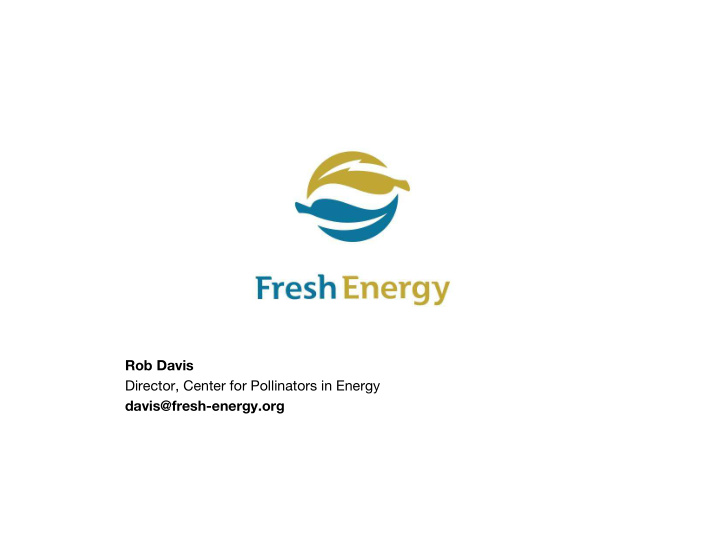



Rob Davis Director, Center for Pollinators in Energy davis@fresh-energy.org
Solar array, Ohio Photo: Janelle Patterson, Marietta Times
September 2016 SoCore Energy & Prairie Restorations
September 2017 SoCore Energy & Prairie Restorations Inc.
Aurora Solar 100 MW distributed solar array 16 sites 1,000 acres Pollinator-friendly seed mix used on all sites
North Star Solar 100 MW solar array 1,000 acres Largest single-site array in the Midwest Pollinator-friendly seed mix from Minnesota Native Landscapes used throughout
Nebraska Public Power District Kearney, NE Solar array seeded with >5 million native plants including: • Purple Prairieclover • Indian Blanket • Four Point Evening Primrose • Scarlet Globemallow • Heath Aster • Aromatic Aster • Dwarf Goldenrod
Pollinator Habitat Benefits Agriculture • Economic analysis of wild pollinator contribution to 10 major crops. • In nearly all cases and especially for tomatoes, blueberries, melons, cucumbers, squash, apples, peaches, and bell peppers, • Gross revenues increase directly because of the installation of pollinator habitat—and that’s even after subtracting out implementation costs. http://bit.ly/BeesCrops
Incomplete Pollination • 70% of crops • 100’s of billions / year
InSPIRE: Innovative Site Preparation and Impact Reductions on the Environment § Interest in restoration of ecosystem services of solar sites § What about pollinator services through maintenance of solar-pollinator habitat? The establishment of regional flowering plants and soil preparation methods, either within the solar facility footprint area (e.g., beneath PV panels) and/or in offsite areas adjacent to the solar facility, that attract and support insect pollinators. A B No Vegetation Turf Grass D C Onsite Offsite Pollinator Pollinator Agricultural Benefits of Solar-Pollinator Habitat
Quantifying Potential Solar-Pollinator Agricultural Interactions Total Amount of Highly Pollinator-Dependent Agriculture Near Solar Facilities >40% dependence (e.g., Aizen et al. 2009) Nearly 90,000 acres Agricultural Benefits of Solar-Pollinator Habitat 31
Co-lo locatio ion n of sola lar r & agric ricult ulture ure �
Co-lo locatio ion n of sola lar r & agric ricult ulture ure �
� “…will adopt pollinator-friendly solar standards...” � Once complete, these meadows, filled with native flowering plants and grasses, will create as much bee and butterfly habitat as if 30,000 families were to each plant six-by-twelve-foot pollinator gardens. � �
What constitutes “pollinator-friendly” in the context of a solar array?
Flexible Standard • Percent wildflowers • Percent native species • Diversity of species • # seasons flowering • Nearby assets • Signage? Mgt plan? • Insecticide risk
Local solar project to turn land into pollinator haven “EGP-NA saw the integration of a vegetation plan into the overall site design as an exciting opportunity to proactively support the local farming ecosystem and communities,” EGP-NA representatives wrote in an email interview. “For example, the Aurora solar project uses pollinator friendly seed mix and native plant species and wildlife which results in prairie grasses and flowers throughout the site that contribute to the growth of pollinator species populations. These species like bees and monarch butterflies are critical to supporting the pollination and production of local crops and the preservation and health of farmland and native landscapes.” http://bit.ly/AuroraEGP
Thank you! Rob Davis Director, Center for Pollinators in Energy Fresh Energy davis@fresh-energy.org www.fresh-energy.org
Recommend
More recommend